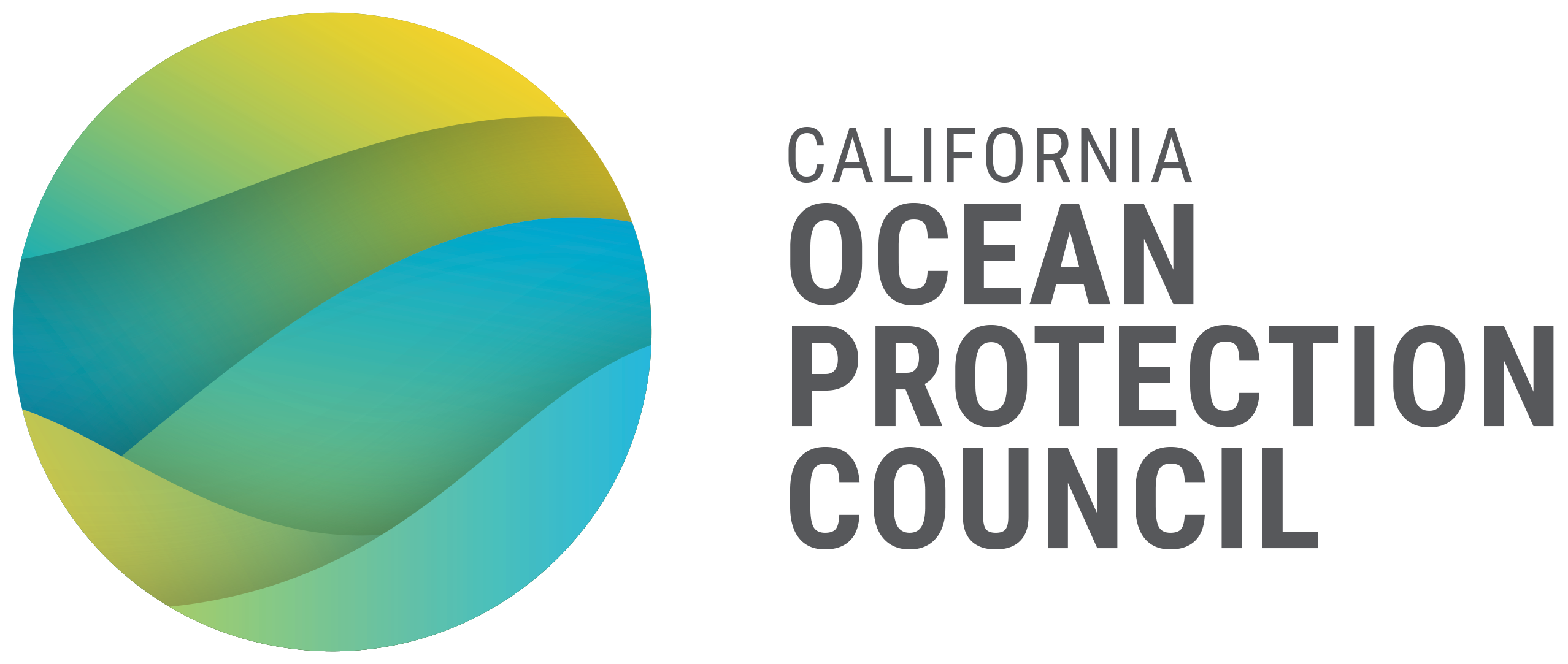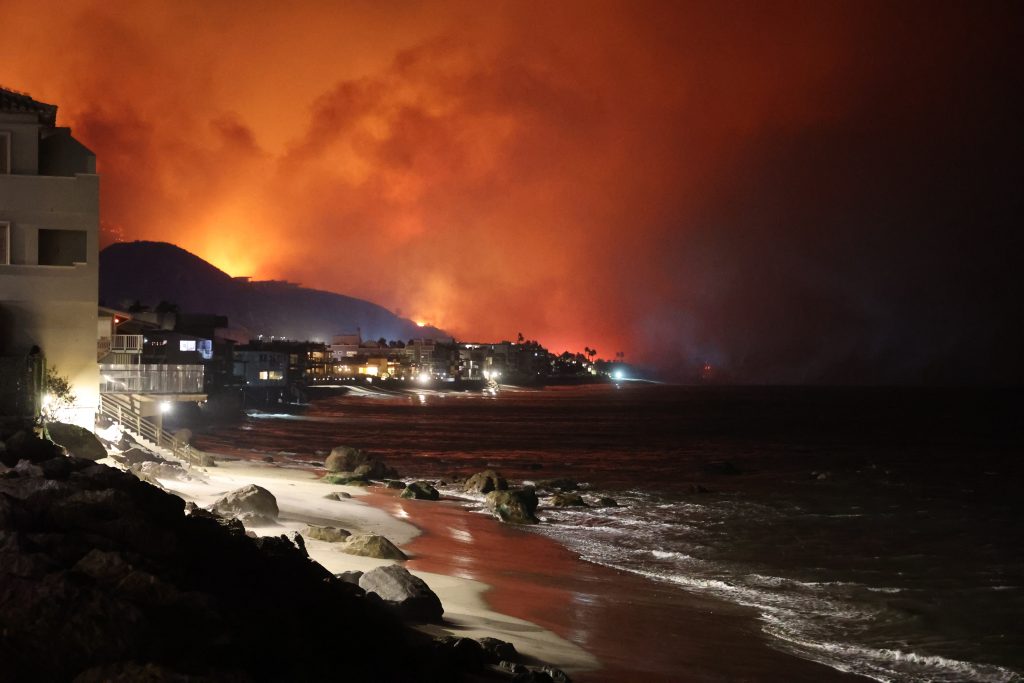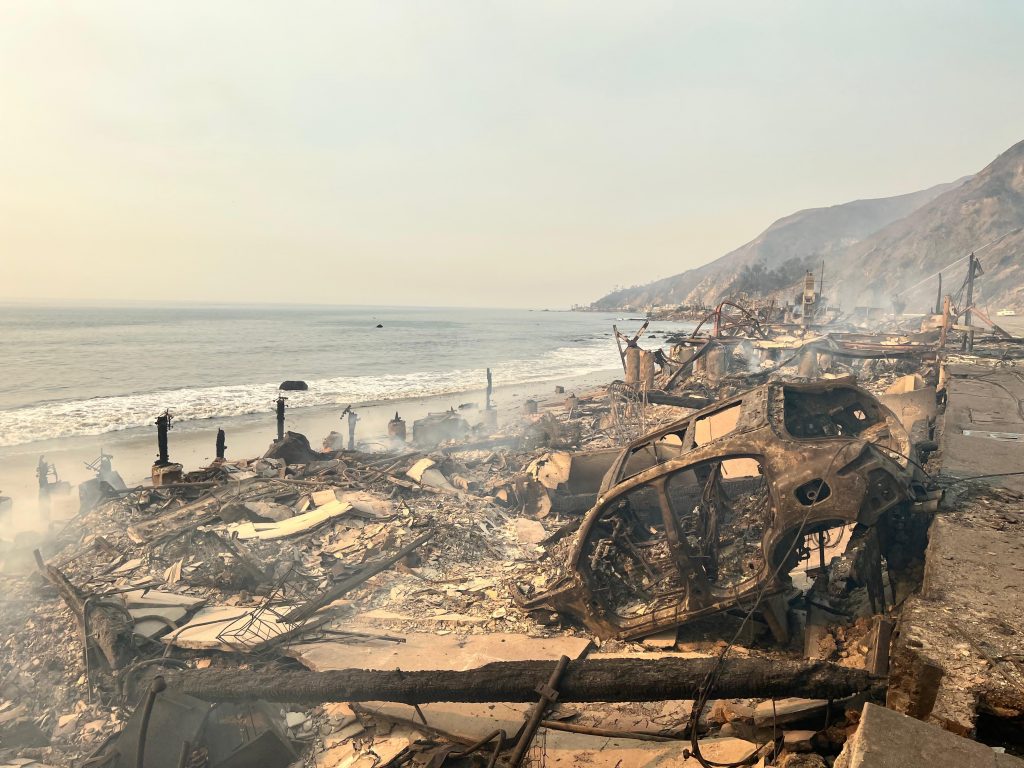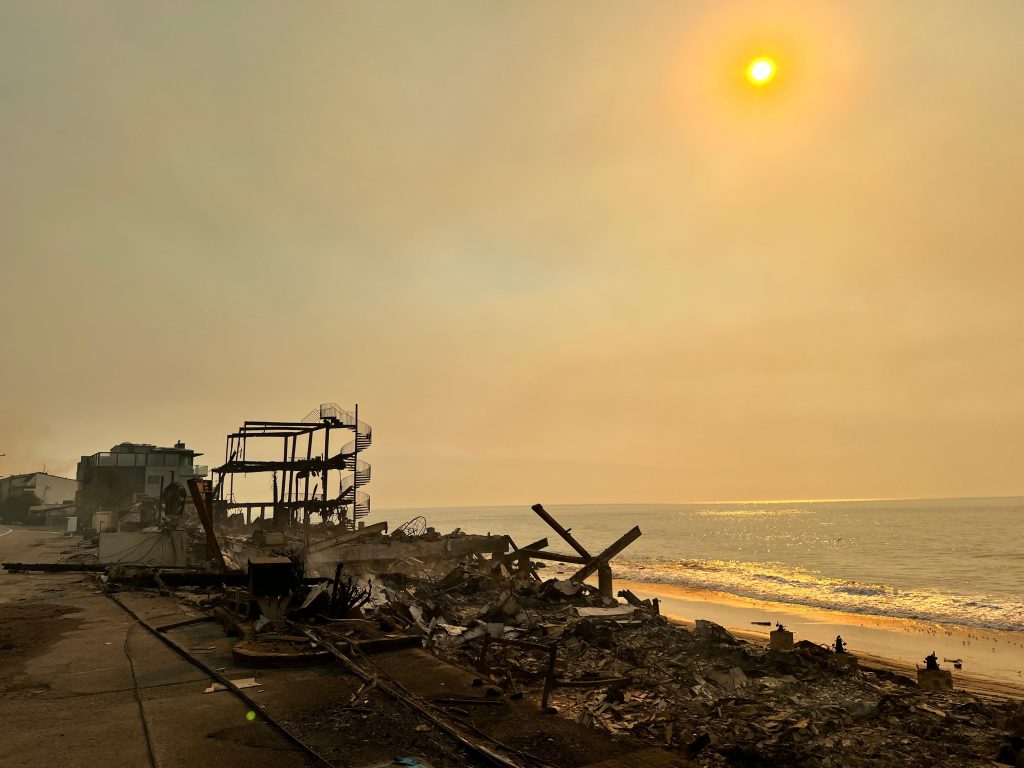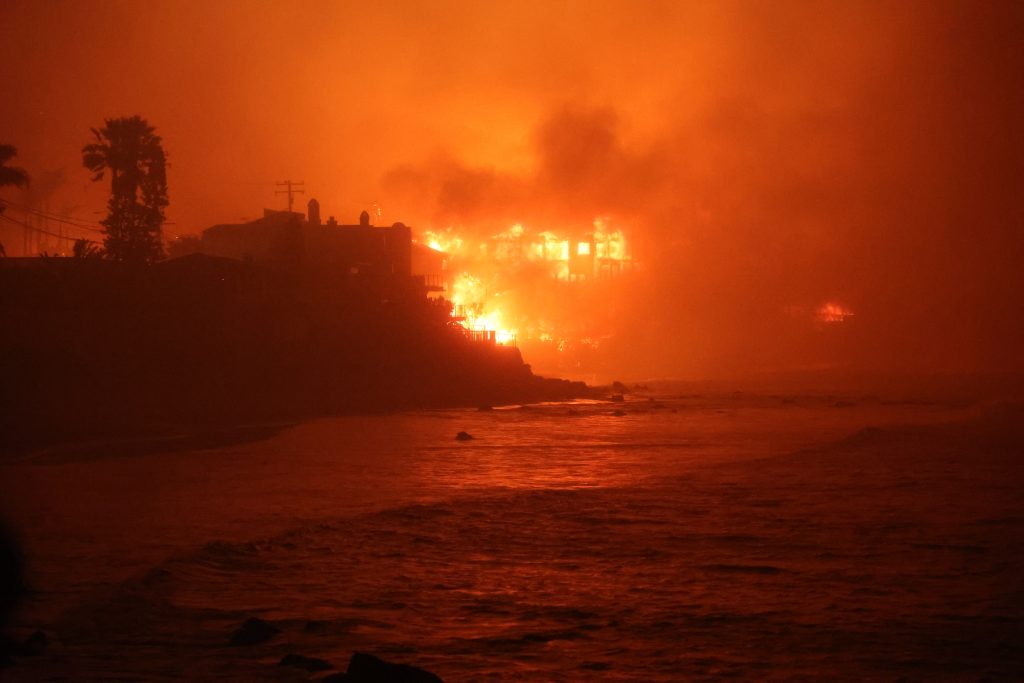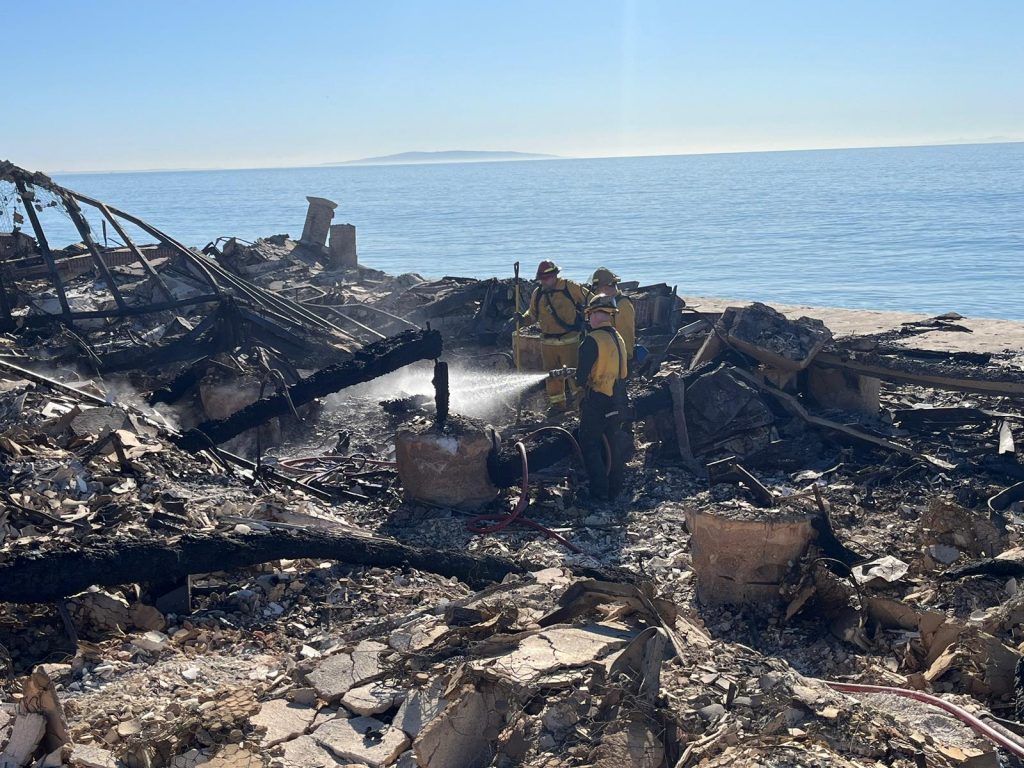From Ashes to Action: Wildfire Impacts on California’s Coast and Ocean Health
The Southern California wildfires have deeply affected individuals and entire communities, with many experiencing devastating losses – loss of life, loved ones, homes, and livelihoods – leaving a profound and lasting impact. The wildfires will continue to have far-reaching effects on our state.
Some of the effects will also impact California’s ecosystems. Many of California’s ecosystems are wildfire adapted. However, the size and scale of Southern California wildfires are unprecedented. The urban location lends to more toxic runoff with a greater potential to harm coastal and marine ecosystems that could pose significant threats to California’s health, economy, and identity.
Palisades Fire. Photos courtesy of CalFire (source).
Biodiversity and Ecosystem Services
California’s coastline is one of the most biodiverse regions in the world. Burned landscapes release sediment, ash, chemicals, and debris into waterways, which flow into the ocean, causing direct harm to ecosystems all along the way that could impact our state’s rich biodiversity.
Harmful impacts include:
- Toxicity: Ash, fire retardants, and debris contain heavy metals and chemicals that can poison filter feeders like mussels and clams and disrupt fish reproduction.
- Nutrient Pollution: Excess nitrogen and phosphorus from ash and chemical runoff can trigger harmful algal blooms, creating hypoxic (low oxygen) dead zones where marine life cannot survive.
- Habitat Loss: Sedimentation can smother kelp forests and seagrass beds, reducing critical habitats for marine species. Wetlands may face significant damage from debris accumulation and altered water flow.
- Breeding and Food Chain Disruption: Coastal fires destroy nesting and roosting sites for seabirds, while marine mammals face indirect threats from polluted waters that may reduce prey availability.
Fires also introduce debris, including charred construction materials and household plastics that break down into harmful microplastics. Microplastics accumulate in the food chain, impacting both wildlife and human health.
California’s coastal ecosystems don’t just provide habitats for wildlife; they provide essential services to Californians, such as carbon sequestration, pollution filtration, and protection from flooding and sea level rise. Wildfire impacts weaken these services. Wetlands, for example, naturally filter runoff before it reaches the ocean. However, the sheer volume of sediment, ash, and debris from fires can overwhelm these habitats, degrading their ability to protect coastal water quality and wildlife.
Wildfires may also threaten California’s landmark Marine Protected Areas (MPAs), which are vital for conserving marine biodiversity and ecosystem services. Fires near areas such as Point Dume and Point Vicente State Marine Conservation Areas (SMCAs) introduced ash, toxins, and debris that can harm these sensitive habitats. Similarly, runoff from the Eaton Fire may impact areas such as Bolsa Bay/Bolsa Chica Basin SMCAs. Understanding wildfire impacts on these areas is essential for informing long-term MPA monitoring, evaluation, and restoration needs.
Protecting Vulnerable Wildlife
In response to the impacts of wildfires on California’s waterways and wildlife, the California Department of Fish and Wildlife (CDFW) has undertaken emergency efforts to rescue endangered fish species threatened by sedimentation and turbidity from winter storms that wash debris, ash, and other materials from areas impacted by wildfire into rivers and creeks. Following the Palisades Fire, CDFW biologists relocated endangered Southern California steelhead trout from Topanga Creek, where post-fire runoff and debris posed a risk of suffocation and habitat loss. Similarly, tidewater gobies—tiny, federally endangered fish—were rescued from fire-impacted coastal lagoons, where ash and sediment threatened water quality. These rapid response efforts are critical to protecting California’s aquatic biodiversity and ensuring the survival of vulnerable species in fire-affected regions.
Economic and Cultural Impacts
California’s economy depends on industries like tourism, recreation, and fishing, which rely on clean beaches and healthy marine ecosystems. Wildfires depositing ash, toxins, and debris into coastal waters could disrupt these industries. For instance, visitors may avoid areas with poor water quality or debris-covered beaches, impacting the tourism economy. At the same time, subsistence, recreational, and commercial fishing communities may face loss of fishing access due to closures. Los Angeles County has issued beach closures and advisories due to water quality and debris concerns, which remain in effect until further notice.
Wildfires also threaten California’s cultural identity. Beaches and the ocean are integral to the state’s character, providing spaces for recreation, inspiration, and community gathering. Fires degrade the beauty that draws people to the coast and reduce access to these cherished places, impacting millions of Californians who depend on them for their well-being and livelihoods.
Monitoring and Recovery
The impacts of wildfires on coastal and ocean ecosystems extend beyond immediate damage. Persistent contamination, habitat degradation, and biodiversity loss can disrupt ecosystems for years. Addressing these issues requires long-term monitoring and mitigation efforts, including sediment control, debris removal, and habitat restoration. These actions are critical for maintaining biodiversity, safeguarding economic stability, and preserving California’s natural heritage.
The California Ocean Protection Council (OPC) is committed to supporting the recovery and resilience of California’s coastal communities and ecosystems. Monitoring the impacts of these catastrophic wildfires on California’s ocean waters, beaches, and wildlife is an urgent need, as state and local officials require real-time data to manage an evolving situation and effectively protect California’s wildlife and coastal communities. Just this past week, OPC provided $200,000 to the Southern California Coastal Water Research Project, in partnership with the Los Angeles Regional Water Quality Control Board, to develop a region-wide network to monitor the impacts of the recent fires on aquatic habitats. This effort will provide much-needed coordination for over 50 agencies, academic institutions, and conservation organizations – bringing together on-the-ground partners to identify key sites and indicators to be monitored, develop recommended methods, and align sampling of water quality, sediment, and wildlife health.
By monitoring recovery actions and arising issues, and maintaining open communication with partners, we can better understand and address issues such as water quality and debris. OPC is dedicated to collaborating with local, state, and federal agencies to effectively equip communities and ecosystems to face these challenges.

